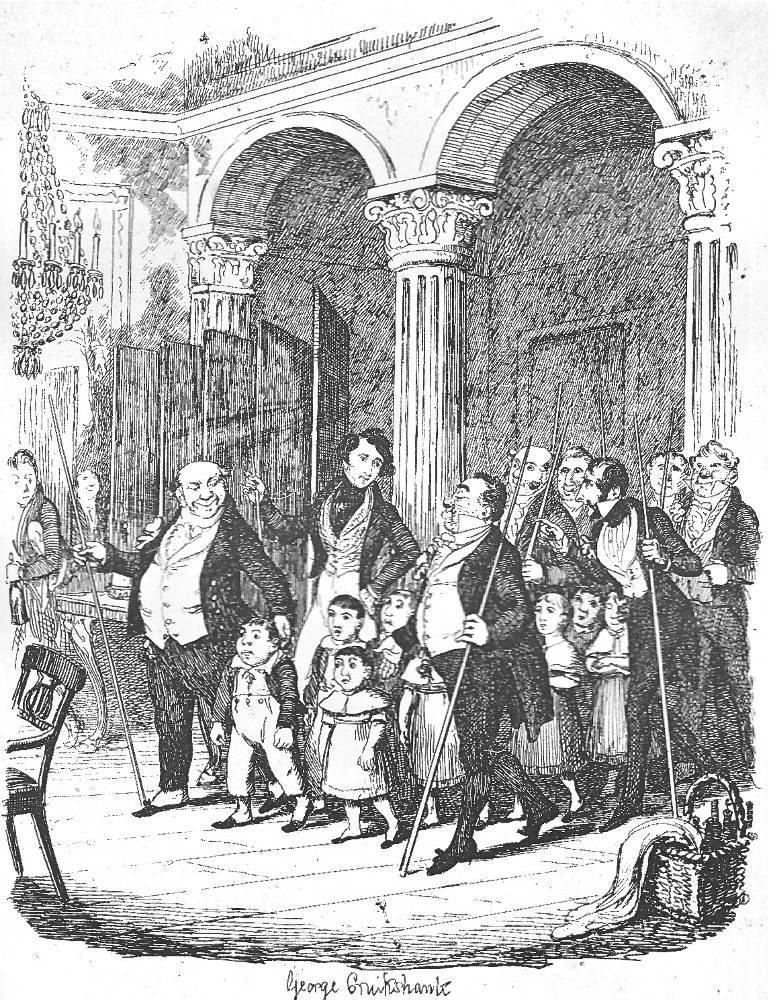
Public Dinner: The Active Commission in Chapter XIX of "Scenes" in Dickens's Sketches by Boz Illustrative of Every-day Life and Every-Day People. Middle of page 149. Wood-engraving; 4 ⅛ by 5 ¼ inches (10.5 cm high by 13.3 cm wide), framed. Perhaps Frost was not familiar of the types of public dinners that the careful observer of the London scene was describing, for he depicts an accident between two waiters that does not actually occur in Dickens's sketch about the event at the Freemasons' Hall.
Scanned image, colour correction, sizing, caption, and commentary by Philip V. Allingham. [You may use this image without prior permission for any scholarly or educational purpose, as long as you (1) credit the person who scanned the image, and (2) link your document to this URL in a web document or cite the Victorian Web in a print one.]
Bibliographical Information
Originally published as "Sketches of London No. 7" in The Evening Chronicle (London) on 7 April 1835, this humorous reportage about a dinner thrown by a public charity appeared in the 1839 (second) Series as "Public Dinners" — the nineteenth chapter in "Scenes." The accompanying illustration, Public Dinners, features young Charles Dickens himself, accompanied by his publishers, Chapman and Hall, entering an ornate dining-chamber. The 1876 and 1877 Household Editions of Dickens's Sketches by Boz, Illustrative of Every-day Life and Every-Day People each contain a single wood-engraving. Whereas Fred Barnard has depicted voracious diners swilling soup at a great rate in Tureens of soup are emptied with awful rapidity, Frost describes a humorous collision in the hall outside the dining-room.
Passage Illustrated: The Active Commission
The first thing that strikes you, on your entrance, is the astonishing importance of the committee. You observe a door on the first landing, carefully guarded by two waiters, in and out of which stout gentlemen with very red faces keep running, with a degree of speed highly unbecoming the gravity of persons of their years and corpulency. You pause, quite alarmed at the bustle, and thinking, in your innocence, that two or three people must have been carried out of the dining-room in fits, at least. You are immediately undeceived by the waiter — "Up-stairs, if you please, sir; this is the committee-room." Up-stairs you go, accordingly; wondering, as you mount, what the duties of the committee can be, and whether they ever do anything beyond confusing each other, and running over the waiters. [Ch. XIX, "Public Dinners," p. 150]
Commentary
The majority of the fifty-six character-studies, short stories, and scenic descriptions (that is, sketches0 that were collected as Sketches by Boz in 1839 Dickens originally published individually in such popular newspapers and periodicals, including The Morning Chronicle, The Evening Chronicle, The Monthly Magazine, The Carlton Chronicle, and Bell's Life in London, between 1833 and 1836. This particular sketch involving the public-minded dinners thrown in support of worthy charitable causes first appeared as "Sketches of London No. 7" in The Evening Chronicle for 7 April 1835, and is essentially a satirical send-up of such events for benevolent societies with high-sounding but faintly ridiculous names. The witness to the accident in the corridor, the young man in pumps, is presumably Boz himself. His gesture reflects both surprise and dismay. Heightening the observer's response to the accident in the corridor, Frost injects energy into the figure of the observer through having his hair blowing in a stiff draft that runs from behind him towards the colliding waiters. Frost renders the waiter involved a mere caricature, the stock comic fat man, in contrast to his realistic handling of the observer.


Left: George Cruikshank's original First Series illustration for the same sketch, with the Dickens, Cruikshank, Chapman, and Hall ushering in the "indigent orphans," Public Dinners (1839). Right: Harry Furniss's "Public Dinners": The Toast-Master, the frontispiece in which the illustrator depicts the vestry debate between the warring factions (1910).

Above: Fred Barnard's satire of a public dinner tends more towards character comedy than farce or slapstick: Tureens of soup are emptied with awful rapidity (1876).
Bibliography
Ackroyd, Peter. Dickens: A Biography. London: Sinclair-Stevenson, 1990.
Bentley, Nicolas, Michael Slater, and Nina Burgis. The Dickens Index. New York and Oxford: Oxford U. P., 1990.
Davis, Paul. Charles Dickens A to Z: The Essential Reference to His Life and Work. New York: Checkmark and Facts On File, 1999.
Dickens, Charles. "Scenes," Chapter 19, "Public Dinners." Sketches by Boz. Illustrated by George Cruikshank. London: Chapman and Hall, 1839; rpt. 1890. Pp. 120-25.
Dickens, Charles. "Scenes," Chapter 19, "Public Dinners." Sketches by Boz. Illustrated by Fred Barnard. The Household Edition. London: Chapman and Hall, 1876. Pp. 77-79.
Dickens, Charles. Section 2, "Scenes." Ch. XIX, "Public Dinners." Sketches by Boz, Illustrative of Every-day People and Every-day Life. The Household Edition. Illustrated by A. B. Frost. New York: Harper and Brothers, 1877. (copyrighted in 1876). Pp. 149-52.
Dickens, Charles. "Scenes," Chapter 19, "Public Dinners." Sketches by Boz. Illustrated by Harry Furniss. The Charles Dickens Library Edition. London: Educational Book Company, 1910. I, 154-59.
Dickens, Charles, and Fred Barnard. The Dickens Souvenir Book. London: Chapman & Hall, 1912.
Slater, Michael. Charles Dickens: A Life Defined by Writing. New Haven and London: Yale U. P., 2009.
Last modified 2 June 2019